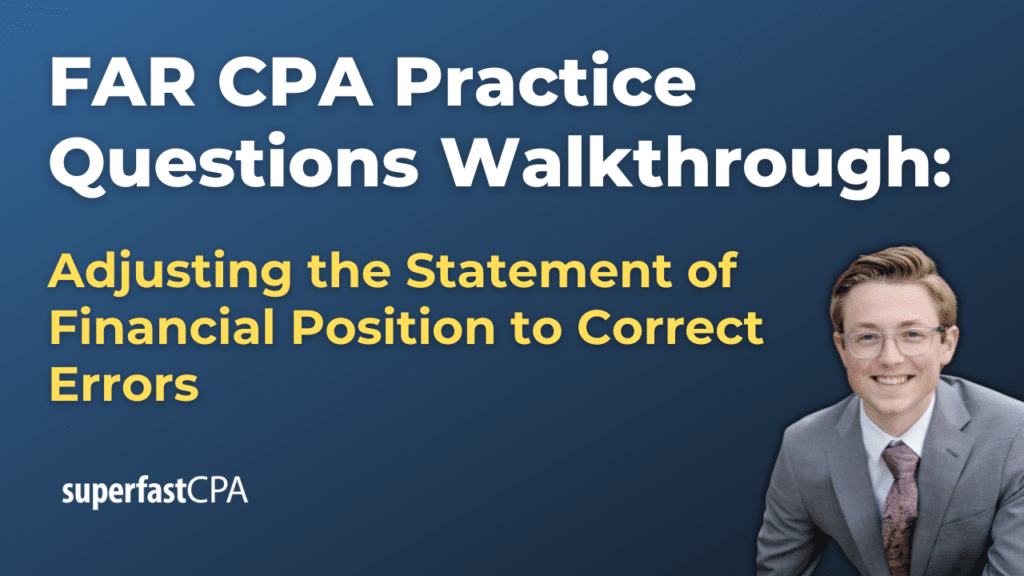In this video, we walk through 5 FAR practice questions teaching about adjusting the statement of financial position to correct errors. These questions are from FAR content area 1 on the AICPA CPA exam blueprints: Financial Reporting.
The best way to use this video is to pause each time we get to a new question in the video, and then make your own attempt at the question before watching us go through it.
Also be sure to watch one of our free webinars on the 6 “key ingredients” to an extremely effective & efficient CPA study process here…
Adjusting the Statement of Financial Position to Correct Errors
The statement of financial position, also known as the balance sheet, is a critical document that reflects the financial health of an organization at a specific point in time. For not-for-profit organizations, accurately classifying and reporting net assets on the statement of financial position is vital to ensure transparency, regulatory compliance, and trust with stakeholders. However, errors can occur, particularly when it comes to the classification and recognition of donor-restricted funds, pledges, and endowments.
Misclassification of Net Assets:
One of the most frequent mistakes is misclassifying net assets as without donor restrictions when they should be with donor restrictions, or vice versa. This misclassification can lead to significant discrepancies in how an organization’s financial position is perceived.
Example: Suppose a not-for-profit organization receives a $100,000 donation that the donor stipulates must be used for a specific program. Initially, the organization classifies this as with donor restrictions. However, once the program is completed, the organization fails to reclassify the funds as without donor restrictions. To correct this error, the organization must reclassify the $100,000 from with donor restrictions to without donor restrictions on the statement of financial position, reflecting that the restriction has been satisfied.
Incorrect Recognition of Conditional Pledges:
Conditional pledges should not be recognized as revenue or receivables until the condition is met. Mistakenly recognizing these pledges prematurely can inflate the organization’s assets and lead to future complications.
Example: A not-for-profit organization receives $150,000, contingent on raising an additional $150,000 from other donors. The organization records the $150,000 as revenue without donor restrictions immediately, even though the condition has not been met. The correct action is to record the $150,000 as a refundable advance (liability) rather than as revenue, and only recognize it as revenue once the matching funds are raised.
Improper Handling of Permanent Endowments:
Permanent endowments must be classified as with donor restrictions because the principal is required to be maintained in perpetuity. Errors occur when organizations mistakenly classify these funds, or the earnings from them, as without donor restrictions.
Example: Consider an organization that receives a $250,000 permanent endowment. The endowment generates $20,000 in earnings, which are not restricted by the donor for any specific purpose. The organization initially classifies both the endowment and the earnings as with donor restrictions. However, only the endowment should remain with donor restrictions, while the $20,000 in earnings should be reclassified as without donor restrictions.
Partial Program Completion and Reclassification Errors:
When a donor-restricted program is partially completed, only the corresponding portion of the funds should be reclassified from with donor restrictions to without donor restrictions. Errors arise when the entire amount is reclassified prematurely.
Example: A not-for-profit organization receives a $200,000 donation to fund a multi-year program. In the first year, $50,000 worth of the program is completed, but the organization mistakenly reclassifies the entire $200,000 as without donor restrictions. To correct this, the organization should only reclassify the $50,000 associated with the completed portion of the program, leaving the remaining $150,000 as with donor restrictions until the more of the program is completed.
Unconditional Promises to Donate:
Unconditional promises to donate should be recognized as receivables and revenue with donor restrictions when the promise is made, with reclassification to without donor restrictions as the funds are received. Errors often involve recognizing the full amount as revenue without donor restrictions upfront.
Example: A not-for-profit organization receives an unconditional promise to donate $120,000, with the total amount to be received over the next four years. The organization incorrectly recognizes $60,000 as revenue without donor restrictions in the current year. The correct approach is to recognize the full $120,000 as a receivable with donor restrictions and then reclassify portions as without donor restrictions each year as the funds are received.
Conclusion
Adjusting the statement of financial position to correct errors is an essential practice for maintaining the integrity of financial reporting in not-for-profit organizations. By understanding common errors and their appropriate corrections, organizations can ensure that their financial statements accurately reflect their financial position, fostering trust and compliance with donors, regulators, and other stakeholders.













